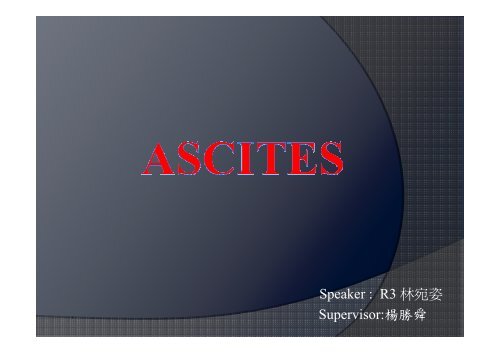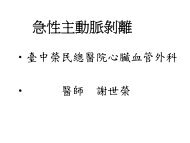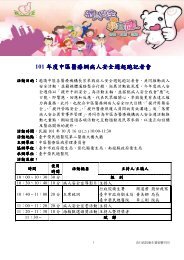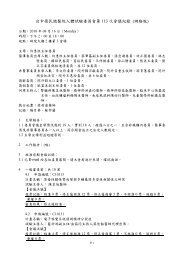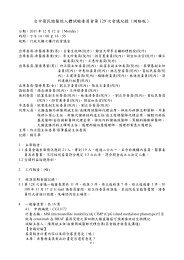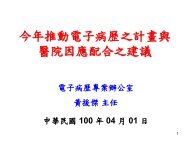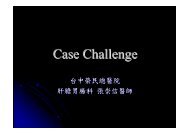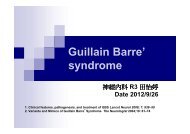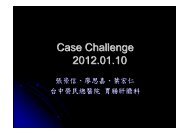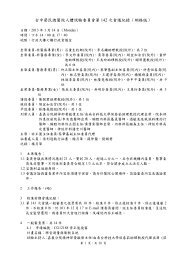ascitic fluid total protein
ascitic fluid total protein
ascitic fluid total protein
- No tags were found...
You also want an ePaper? Increase the reach of your titles
YUMPU automatically turns print PDFs into web optimized ePapers that Google loves.
Portal hypertensionincreased resistance to portal blood flow prehepatic, intrahepatic, and posthepaticIntrahepatic sites of increased resistance presinusoidal, sinusoidal, or postsinusoidalSite Site CausePre-hepatic Extra-hepatic Portal vein thrombosis,↑splenic flowHepatic Sinusoidal Liver cirrhosisPost-hepaticPost-sinusoidalTumorRight heart failure,IVC occlusion
Pathogenesis ( non-Cirrhotic) Heart failure & Nephrotic syndrome MalignancyPeritoneal carcinomatosis( tumor cell production )Occlusion of portal veinsLymph node obstructionRupture of chyle-containing lymphatics
Clinical FeatureMost patients (80%) with ascites Cirrhosis AlcoholChronic hepatitis NASHCauses of AscitesCausative Disorder % of Affected PatientsCirrhosis (with or without infection) 85Miscellaneous portal HTN–related disorder 8Cardiac disease 3Peritoneal carcinomatosis 2Miscellaneous nonportal HTN– related disorders 2Ann Intern Med 117:215, 1992.
Physical examination Ultrasound : >100ml of <strong>fluid</strong> Shifting dullness : >1500ml of <strong>fluid</strong> Fluid wave : not useful Puddle sign : not useful( old lecture: can detect acites < 200ml )
DiagnosisAbdominal paracentesis~most efficient way to confirmIndication :Diagnosis Relief of symptomsDetection of infectionComplication :Abdominal wall hematoma 1%Bowel entry / hemoperitoneum < 1/1000No death reported in recent years
Diagnosisrisks and costs of prophylactictransfusions exceed the benefit.
AASLD PRACTICE GUIDELINERecommendations1. Abdominal paracentesis should beperformed and <strong>ascitic</strong> <strong>fluid</strong> should beobtained from inpatients and outpatients withclinically apparent new-onset ascites.(Class I, Level C)2. Since bleeding is sufficiently uncommon, theprophylactic use of FFP or platelets beforeparacentesis is not recommended.(Class III, Level C)
Ascitic <strong>fluid</strong> analysis Gross appearanceTransparent / yellow Neu< 250 /cummCloudy (mayonnaise) Neu>50000/cummPinkRBC>10000/cummRedRBC>20000/cummMilkyTG>200 mg/dlDark brown JaundiceBlackMelanoma
Ascitic <strong>fluid</strong> analysisAscitis <strong>fluid</strong> testRoutineOptionalUnusualUnhelpfulCell count /DCAlbuminGlucoseLDHAmylaseGram stainCulture inbloodculturebottlesTB smear &TB cultureCytologyTGBilirubinpHLactateCholesterolFibronectin
Ascitic <strong>fluid</strong> analysisCell CountWBC elevation Diuresis Inflammatory>> Peritonitis ( PMN >250 /cumm )>> TB or Peritoneal carcinomatosis( lymphocyte predominant )
Ascitic <strong>fluid</strong> analysisSerum-AscitesAlbuminGradient (SAAG(SAAG)SAAG= Serum albumin – Ascites albuminSAAG > 1.1 gm/dl portal HTN with accuracy of 97 %False low: Serum albumin < 1.1gm/dlFalse high: chylous ascites / hyperlipidemia
Ascitic <strong>fluid</strong> analysisNormal peritoneumPortal hypertension[SAAG] >1.1 g/dL)Liver diseaseCirrhosisAlcoholic hepatitisFatty liver of pregnancyFulminant hepatic failureMassive hepatic metastasesHepatic congestionCongestive heart failureConstrictive pericarditisTricuspid insufficiencyBudd-Chiari syndrome
Ascitic <strong>fluid</strong> analysisNormal peritoneumHypoalbuminemia(SAAG
Ascitic <strong>fluid</strong> analysisDiseased peritoneum (SAAG
Ascitic <strong>fluid</strong> analysisRare conditionsFamilial Mediterranean feverGranulomatous peritonitisVasculitisEosinophilic peritonitisWhipple's diseaseEndometriosisSarcoidosisPrimary lymphatic hypoplasia
Ascitic <strong>fluid</strong> analysisCulture PMN count > 250 /cumm (neutrocytic)older culture : 50 % culture rateblood culture : 80 % culture rate
Ascitic <strong>fluid</strong> analysisExudate/TransudateAscitic <strong>total</strong> <strong>protein</strong>> 2.5gm/dl Exudate< 2.5gm/dl TransudateLess used in recent days !!
Ascitic <strong>fluid</strong> analysisTotal <strong>protein</strong> Ascites <strong>fluid</strong> <strong>total</strong> <strong>protein</strong> (AFTP):SAAG > 1.1 to distinguishCirrhosis (AFTP< 2.5g/dl) fromCardiac ascites (AFTP>2.5g/dl) Low <strong>ascitic</strong> <strong>protein</strong> susceptible to SBP
AASLD PRACTICE GUIDELINERecommendations3. The initial laboratory investigation of <strong>ascitic</strong> <strong>fluid</strong>should include an <strong>ascitic</strong> <strong>fluid</strong> cell count anddifferential, <strong>ascitic</strong> <strong>fluid</strong> <strong>total</strong> <strong>protein</strong>, andSAAG.(Grade II-2)4. If <strong>ascitic</strong> <strong>fluid</strong> infection is suspected, <strong>ascitic</strong> <strong>fluid</strong>should be cultured at the bedside in bloodculture bottles.(Grade II-2)
Ascitic <strong>fluid</strong> analysisSBP Vs. Gut perforationA. Neutrocytic ascitesB. Total <strong>protein</strong> > 1gm/dlLDH > ULN ( mostly ½ serum level)Glucose < 50mg/dl 2 of three meet critieriapreferred to Gut perforationJ Hepatol 2001;34:215–221.
Ascitic <strong>fluid</strong> analysisAmylase Normal range : ½ serum level ( 50 U/L) If > 2000 U/L Acute pancreatitis Gut perforation
Ascitic <strong>fluid</strong> analysisGram stainGram stain(+) 10000 bacteria / mlSBP 1 organismMost helpful in Gut perforation
Ascitic <strong>fluid</strong> analysisTB culture & Smear TB culture of 1000ml of ascites~ 50 % sensitivity rateTB smear of ascites ~ near 0 % sensitivity rate Laparoscopy with histology/bx culture~ almost 100% sensitivity rate~ most accurate & rapid method DNA probe ~ a new methodHEPATOLOGY 1996;24:1408–1412.
Ascitic <strong>fluid</strong> analysisCytology examOnly sensitive to peritoneal carcinomatosisSensitivity rate 96.7% if 3 samples are sentSensitivity rate 93.3% if 2 samplesHEPATOLOGY 1988;8:1104–1109.
Ascitic <strong>fluid</strong> analysis TriglycerideChylous ascites : ascites TG>200mg/dlMeasured as milky ascitesPresence of intestinal or thoracic LNs BilirubinAscites bilirubin : ascites > 6mg/dl or greaterthan serum levelMeasured as dark brown ascites> serum level Upper Gut perforation biliary tract perforation
Treatment of AscitesLow SAAG ascites treat underlying diseaseNon-ovarian peritoneal carcinomatosis : tap.Ovarian peritoneal carcinomatosis: debulky opTB peritonitis : tx TBPancreatic ascites: resolved spontaneousChlamydia peritonitis : TetracyclinLupus serositis : steroid
Treatment of AscitesHigh SAAG ascites related to portal HTN
AASLD PRACTICE GUIDELINERecommendations6. Patients with ascites who are thought to have analcohol component to their liver injury shouldabstain from alcohol consumption.(Grade II-2)7. First-line treatment of patients with cirrhosis andascites consists of sodium restriction (88 mmolper day [2000 mg per day]) and diuretics (oralspironolactone and furosemide).(Grade I)
AASLD PRACTICE GUIDELINERecommendations8. Fluid restriction is not necessary unless serumsodium is less than 120-125 mmol/L.(Grade III)9. An initial therapeutic abdominal paracentesisshould be performed in patients with tenseascites. Sodium restriction and oral diureticsshould then be initiated.(Grade II-3)
AASLD PRACTICE GUIDELINERecommendations10. Diuretic-sensitive patients should preferablybe treated with sodium restriction and oraldiuretics rather than with serial paracenteses.(Grade III)11. Liver transplantation should be considered inpatients with cirrhosis and ascites.(Grade II-3)
AASLD PRACTICE GUIDELINERecommendationsRefractory Ascites12. Serial therapeutic paracenteses may be performedin patients with refractory ascites.(Grade III)13. Post-paracentesis albumin infusion may not benecessary for a single paracentesis of < 4 to 5L.For large-volume paracenteses, an albumin infusionof 8 to 10 g per liter of <strong>fluid</strong> removed can beconsidered.(Grade II-2)
AASLD PRACTICE GUIDELINERecommendationsRefractory Ascites14. Referral for liver transplantation should be expeditedin patients with refractory ascites.(Grade II-3)15. TIPS should be considered in appropriately selectedpatients who meet criteria similar to those of publishedrandomized trials.(Grade I)16. Peritoneovenous shunt should be considered for patients withrefractory ascites who are not candidates for paracenteses,transplant, or TIPS. (Grade I)
Thanks foryour attention !!


